The U.S. House of Representatives and Senate have passed major health reform bills. On November 7, the full House voted to pass H.R. 3962, The Affordable Health Care for America Act. On December 24, the full Senate voted to pass H.R. 3590, The Patient Protection and Affordable Care Act.
This report analyzes the provisions of the bills that seek to expand and improve health insurance coverage in the United States. It builds on an earlier report published by The Commonwealth Fund that explains the provisions of the congressional health reform bills in detail.
In this report, we focus on: the number of people who would likely gain coverage under the two bills; under which program or plan they would be covered and the consequences for federal financing; the estimated insurance premium and out-of-pocket costs for families; the consequences of the bills for employers; and the degree to which the reorganization and regulation of insurance markets in the bills has the potential to stimulate price competition and lower costs. A companion Commonwealth Fund report analyzes the bills' implications for health system reform.
Overall Approach of the Health Reform Bills
The House bill and the Senate bill both aim to provide near-universal health insurance coverage. They would do so by building on the strongest aspects of the insurance system—large-employer insurance, Medicaid, and the Children’s Health Insurance Program (CHIP)—and by regulating and reorganizing the individual and small group insurance markets, generally considered the weakest part of the system (Exhibit ES-1). 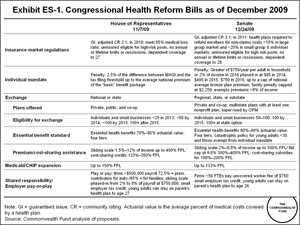
- The bills would establish new federal rules requiring insurance carriers in all markets to accept every individual and employer who applied for coverage (guaranteed issue) and prohibit rating based on health status.
- The bills would create a new health insurance exchange operated either at the national or state level in which eligible individuals and businesses could purchase health insurance, choosing between private and public health plans.
- Premium and cost-sharing subsidies would be available on a sliding scale to offset the costs of plans purchased through the exchange. An essential standard benefit package, with different levels of cost-sharing, would set a floor for plans offered through the exchange.
- Income eligibility for Medicaid and CHIP would be expanded up to 133 percent or 150 percent of the federal poverty level.
- Large employers would be required to either offer coverage or contribute to the cost of their employees' insurance. Small employers would be eligible for tax credits to offset the costs of insurance.
- Individuals would be required to have health insurance.
How Much Would the Proposals Cost the Federal Government?
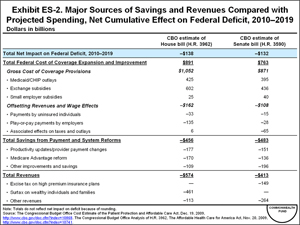 The Congressional Budget Office (CBO) has estimated that the bills would reduce the federal deficit over the next 10 years by $138 billion (House) and $132 billion (Senate) (Exhibit ES-2). The estimated cost over 10 years of expanding and improving health insurance is $891 billion under the House bill and $763 billion under the Senate bill. Costs would be offset by contributions from employers, savings from health system reforms, and new revenues.
The Congressional Budget Office (CBO) has estimated that the bills would reduce the federal deficit over the next 10 years by $138 billion (House) and $132 billion (Senate) (Exhibit ES-2). The estimated cost over 10 years of expanding and improving health insurance is $891 billion under the House bill and $763 billion under the Senate bill. Costs would be offset by contributions from employers, savings from health system reforms, and new revenues.
How Many People Would Gain Coverage?
In the absence of health reform, the CBO estimates that the number of uninsured Americans will rise to 54 million by 2019, from 46 million in 2008. The House and Senate proposals would lower that estimate substantially.
- The CBO estimates that the House bill would reduce the number of people without coverage by 36 million, leaving 18 million people without health insurance in 2019 (Exhibit ES-3).
-
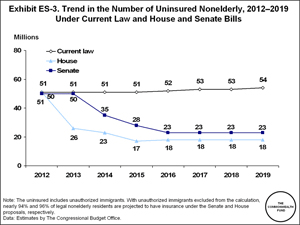 The Senate bill would reduce the number of people without insurance by about 31 million, leaving 23 million people uninsured in 2019.
The Senate bill would reduce the number of people without insurance by about 31 million, leaving 23 million people uninsured in 2019. - The CBO estimates that, under the House and Senate bills, employer-sponsored insurance would remain the primary source of insurance for most families, covering about 56 percent to 60 percent of the under-65 population in 2019.
- Small to mid-size companies purchasing coverage through the exchange would bring about 5 million to 9 million people into the exchanges under the Senate and House bills.
- Under both bills, the exchanges would provide a new source of coverage to an estimated 30 million people by 2019, by allowing either individuals or companies to purchase coverage in the exchanges.
- Under both bills, the number of people covered through the Medicaid program would increase by 15 million, from 35 million today to about 50 million by 2019.
!!!PAGE BREAK!!!
Would Health Insurance Be More Affordable and Protective?
Overall, the House and Senate bills would make health insurance coverage more affordable and provide protection against heavy financial burdens, especially for uninsured people, people who purchased coverage on the individual market, and small businesses. Specific improvements in affordability and protection would stem from:
- an expansion of Medicaid eligibility;
- new insurance market regulations against rating on the basis of health, limits on rating on the basis of age, and prohibitions against annual or lifetime limits on benefits or cancellations of medical coverage after policyholders have become sick or injured;
- new essential benefit standards;
- premium subsidies for lower- and middle-income people who purchase insurance on their own;
- cost-sharing subsidies and out-of-pocket limits that reduce out-of-pocket expenses and improve the financial protection of the plans for people who become sick; and
- insurance reform provisions aimed at slowing the overall rate of growth in health care costs and premiums, including a reduction in administrative costs, the insurance exchange's authority to review and reject premiums, and a public health insurance option.
Affordability of Premiums
Provisions in the bills that would affect premiums paid by families include: the share of medical costs covered by the plan (known as "actuarial value"), the size of the premium subsidies, the degree to which premiums are allowed to vary by age, and how the premium subsidies are allowed to grow over time.
Premium Subsidies
-
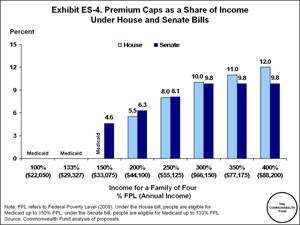 For families earning less than 400 percent of the federal poverty level who are eligible to purchase health insurance through the exchange, the bills would provide premium subsidies that would cap premium costs as a share of income.
For families earning less than 400 percent of the federal poverty level who are eligible to purchase health insurance through the exchange, the bills would provide premium subsidies that would cap premium costs as a share of income. - For families with incomes between 150 percent and 400 percent of the poverty level, the House bill would limit people's premium contributions to 3 percent of income at just over 150 percent of poverty and rise to 12 percent (those at 150 percent of poverty or less would be eligible for Medicaid). The Senate bill would limit people’s premium contributions to about 4 percent of income at just over 133 percent of poverty and gradually increase them to 9.8 percent for families with incomes between 300 and 400 percent of poverty (those at 133 percent of poverty or less would be eligible for Medicaid) (Exhibit ES-4).
- Families earning less than $55,125 per year would pay a larger share of their incomes on premiums under the Senate bill than under the House bill, while those with higher incomes ($77,000–$88,000) would pay a larger share of their income under the House bill.
Premiums for Older Adults
Currently, older people generally pay higher premiums in the individual market than younger people do, because their expected medical expenses are higher. Similarly, insurance carriers will charge small companies with older workforces higher premiums. Premiums can vary by age by as much as 25 to 1 in the individual and small-group markets. Both the House and the Senate bills place limits on the degree to which premiums can rise with age (these limits are known as "age bands"). The Senate bill specifies slightly wider age bands than the House bill (3:1 vs. 2:1). This means that older adults under the Senate bill could face somewhat higher premiums than they would under the House bill, and young adults would face lower premiums in the Senate bill compared with the House bill (Exhibit ES-5).
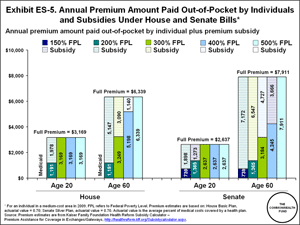
A 60-year-old with income too high to qualify for a subsidy could spend about $7,900 on premiums under the Senate bill, compared with $6,339 in the House bill. In contrast, under the House bill, a 20-year-old could spend about $3,169 on premiums, compared with $2,637 under the Senate bill.
Out-of-Pocket Costs
The House and Senate bills would offer greater protection against out-of-pocket costs to families purchasing health insurance through the insurance exchanges, compared with the costs many families currently face in the individual market:
- New insurance market regulations would ensure that people in poor health could not be turned down or have a condition excluded from coverage.
- Essential benefit packages would ensure that people would have comprehensive health benefits without lifetime or annual limits, and with prohibitions against cancellation if someone becomes sick.
- The out-of-pocket spending limits in each of the bills would provide substantial protection from high out-of-pocket costs for people who have high medical costs in a given year, particularly those who become very sick.
- Each of the bills provides greater protection from out-of-pocket costs for people with low and moderate incomes by reducing cost-sharing and lowering out-of-pocket spending limits. The House bill would provide greater protection from out-of-pocket costs for people with low and moderate incomes, compared with the Senate bill.
Individual Requirement to Have Health Insurance
To ensure broad risk-pooling across health status and age and to prevent adverse selection into the new exchanges and Medicaid program, the bills require everyone in the United States to have health insurance, with some exemptions. The Senate bill would exempt many more people from the mandate than the House bill would.
- The House bill stipulates a penalty for not having insurance that would vary with income: 2.5 percent of the difference between an individual’s modified adjusted gross income (modified to include tax-exempt interest and certain other sources of income) and the tax-filing threshold, up to the cost of the average national premium for the basic benefit plan. In practice, the penalty would amount to about $242 for a single person earning between $20,000 and $30,000, $703 for someone earning between $40,000 and $50,000, $1,570 for someone earning $75,000 to $100,000, and about $2,510 for someone earning between $100,000 and $200,000. The penalty is capped at about $3,500 per person.
- The Senate bill would require the greater of a flat penalty of $750 per person per year, or 2 percent of income in 2016, up to a cap of the national average “bronze” plan premium, phased in at $95 in 2014, $495 in 2015, and $750 in 2016.
- Financial hardship exemptions are provided in the Senate bill for those individuals for whom the premium would exceed 8 percent of income; there are unspecified exemptions for financial hardship in the House bill.
Employer Shared Responsibility
The bills would require large employers to contribute to the cost of their employees’ coverage, with the House bill specifying larger responsibilities for employers than the Senate bill.
- The House bill would require employers to contribute at least 72.5 percent of the premium cost for single coverage and 65 percent of the premium cost for family coverage of the lowest-cost plan that meets the bill’s qualified health benefits plan requirements. This is substantially below the average contributed by employer plans now (84% for single coverage and 73% for family coverage).
- The Senate bill does not set standards on employer coverage but does require employers to contribute to the cost of covering uninsured workers who receive premium subsidies through the exchanges.
Penalties and Small-Business Exemptions
- The House bill requires employers with payrolls of $750,000 or more to meet the coverage requirements or pay 8 percent of payroll into a health insurance exchange trust fund. The penalty is less than the average share of payroll that employers currently spend on premium contributions, which is about 12 percent.
- The Senate bill would require larger firms (i.e., those with 50 or more workers) that do not offer coverage to pay $750 per full-time worker if any worker receives a subsidy through the exchange. Firms that do offer coverage, but have workers who contribute more than 9.8 percent of their income toward their premiums and are eligible to receive subsidies through the exchange, must pay the lesser of $3,000 for each full-time worker receiving a credit or $750 for every worker.
- The Senate bill also penalizes employers for imposing waiting periods for new employees. Large employers would pay $600 for each full-time worker in a waiting period of more than 60 days.
Small-Business Tax Credits and Subsidies
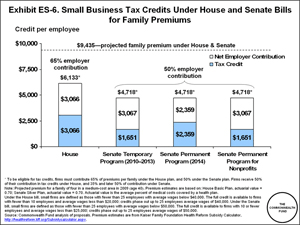 Each of the bills also helps small businesses by providing tax credits to employers who contribute a specified share of their employees' premiums. The Senate bill requires a lower premium contribution than the House bill for employers to be eligible for the tax credit, and it allows firms with somewhat higher average wages to qualify.
Each of the bills also helps small businesses by providing tax credits to employers who contribute a specified share of their employees' premiums. The Senate bill requires a lower premium contribution than the House bill for employers to be eligible for the tax credit, and it allows firms with somewhat higher average wages to qualify.
- Under the House bill, tax credits for up to two years would be available to employers with fewer than 10 employees or average wages of $20,000; these would then phase out for employers with up to 25 employees or average wages of $40,000 per year. The full credit would equal 50 percent of the premium paid by a small employer who is in compliance with the mandate or who is paying 72.5 percent of premium for single coverage and 65 percent of premium for family coverage, for up to two years. If a company is eligible for the full tax credit and offers the House basic plan and contributes 65 percent of the premium for families, it would receive a tax credit of about $3,066 per worker, leaving it with a balance of $3,066 (Exhibit ES-6).
- For firms that have 10 employees or fewer and average wages below $25,000, and that contribute 50 percent of their employees’ premiums, the Senate bill would provide tax credits for up to two years. These credits would be phased out for firms with up to 25 employees and average wages of $50,000. From 2010 to 2013, the bill would provide tax credits worth 35 percent of the premium contribution; beginning in 2014, the credits would be worth 50 percent of the contribution. Assuming that a company that is eligible for the full credit offers the Senate "silver plan" and contributes 50 percent of a family premium, it would be eligible for a tax credit of $1,651 per worker in the first two years, leaving it with a balance of $3,067, and a credit of $2,359 per worker after that, leaving it with a balance of $2,359.
Insurance Market Regulations and the Insurance Exchange
Each bill would bring sweeping change to the individual and small-group insurance markets through new national insurance market regulations. This would be combined with a reorganization of the markets, either by substituting a new national insurance exchange for the individual market in the case of the House bill, or the creation of state or regional exchanges in the Senate bill. The exchanges in the Senate bill would operate alongside the existing individual and small-group markets, under the same rules.
- There are key differences in the design of the exchanges in the bills, including the exclusivity of the exchange vis-à-vis other markets, the authority of the exchanges to review and reject premiums proposed by carriers, and consumer choice of a public plan. These differences have significant implications for the long-term ability of the exchange to increase price competition among carriers and providers and lower costs.
- The House bill establishes an insurance exchange with potentially greater regulatory and market power, and thus greater potential to reduce premiums and costs over time, than the Senate bill. This is due to provisions in the House bill for: full replacement of the individual insurance market; direct federal control of the exchange; the ability of the U.S. Secretary of Health and Human Services to review and reject premiums proposed by participating insurance carriers; and a new public health insurance plan.
!!!PAGE BREAK!!!
Conclusion
The House and Senate bills would significantly reform the U.S. health insurance system, providing coverage to more than 30 million uninsured Americans and substantially improving the affordability of health insurance coverage for small businesses and for people currently buying health insurance on their own. Moreover, the system reform and revenue provisions in both bills would more than offset the federal costs of expanding and improving health insurance coverage: the CBO estimates that both bills would reduce the federal deficit by $132 billion to $138 billion over 10 years.
While the bills are largely similar in their approach to reforming health insurance, there are key differences that have implications for the number of people expected to gain heath insurance, the amount of premiums and out-of-pocket costs paid by families, and the cost of health insurance over time.
- Insurance market reforms. The two bills would prevent underwriting on the basis of health but would allow premiums to rise with age. However, the House bill would allow insurers to charge higher premiums to older people by a lower margin.
- Individual requirement to have health insurance. Both bills would require individuals to have coverage, but the Senate bill would exempt many more people from the mandate.
- Financial protection for low- and moderate-income families. The House bill expands Medicaid eligibility further up the income scale (to 150% of poverty) compared with the Senate bill (133% of poverty) and provides more affordable premiums and greater protection from out-of-pocket costs. As such, the CBO estimates that the cost of premium and cost-sharing subsidies in the House bill are higher than in the Senate bill over 10 years ($602 billion vs. $436 billion, respectively).
- Employer shared responsibility. The House bill would require employers, except for small firms, to offer and contribute a specified share of their workers’ coverage or pay a penalty. The Senate bill would not require employers to offer health insurance but would assess a flat, per-employee fee on employers, with workers receiving federal premium subsidies through the insurance exchanges. Employers will make a greater contribution overall to the House reform plan, providing an estimated $135 billion over 10 years, compared with $28 billion in the Senate.
- Insurance exchanges. Each bill establishes new insurance exchanges that would either substitute or complement existing individual and small-group markets and would be subject to the same market rules (e.g., underwriting and rating). The House bill would replace existing individual markets, but not small-group markets, with a national insurance exchange, although states can elect to run their own exchanges subject to strict rules. The Senate bill would create state or regional exchanges that would operate alongside existing individual and small-group markets. In both bills, all individual and family premium subsidies and cost-sharing subsidies would only apply to private or public plans sold through the exchanges.
- Choice of public health plan through the exchange. The House bill would provide a choice of public, private, and nonprofit cooperative plans sold through the exchange. The Senate bill would provide a choice of private plans, nonprofit cooperative plans, and multistate private plans that would be offered under contract with the federal Office of Personnel Management.
- Risk equalization. The bills include mechanisms aimed at equalizing risks across patients, thereby compensating insurance carriers for high-cost patients and reducing incentive for carriers to “cherry pick” patients who appear to be good health risks. Compared with the House version, the Senate bill provides a more detailed risk-equalization strategy.
Given the growing health insurance crisis facing the nation, it is imperative that Congress complete its historic work on reforms that will place the U.S. health system on the road to high performance.